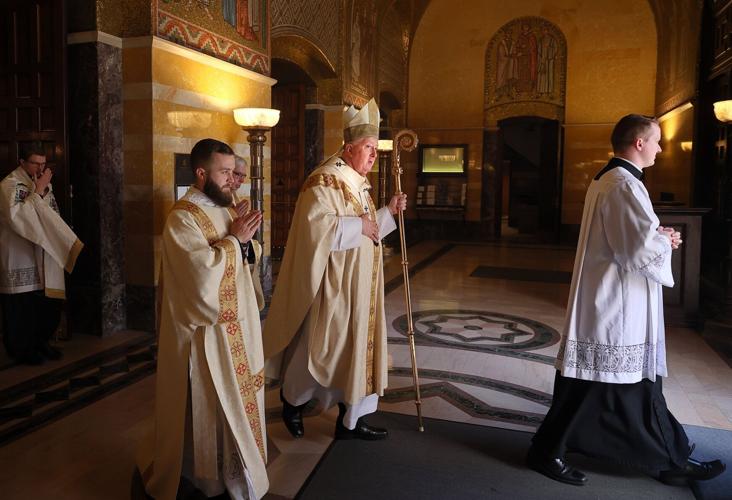MARYLAND HEIGHTS ŌĆö The plan to downsize the Archdiocese of ├█č┐┤½├Į will cut more deeply than first reported, with at least half of the parishes slated to close.
The latest figures from the archdiocese, outlined at a series of parish listening sessions currently underway, show the number of parishes could drop from 178 to between 71 and 90.
In response to the reorganization plan ŌĆö called ŌĆ£All Things NewŌĆØ by the archdiocese ŌĆö a group of parishioners is planning to fight back.
More than 400 Catholics from Perryville, Mo., to Warrenton gathered recently at a hotel conference room at Westport Plaza to plot a response to the upcoming changes.
When the archdiocese announces the reorganization plan in May, these parishioners say they will be ready to appeal all the way to the Vatican under canon, or church, law.
People are also reading…
ŌĆ£Folks are waking up to learn more about their faith including canon law,ŌĆØ said Ken Battis, who helped found in response to All Things New. ŌĆ£We ought to be asking the question of why we have to make the most fundamental, sweeping changes in our history.ŌĆØ
├█č┐┤½├Į Archbishop Mitchell Rozanski intends to follow the requirements of canon law as promised when he took the Oath of Fidelity, a spokeswoman for the archdiocese said Friday.
Maps of potential mergers have been presented at listening sessions that started in mid-October at every parish, where attendees say many of their questions have gone unanswered. Feedback from the listening sessions and a follow-up survey of parishioners will be reviewed by archdiocesan leaders between January and April before final decisions are made, according to the spokeswoman.
Archdiocesan leaders have said the downsizing is necessary as both the number of Catholic faithful and the priests to serve them have dwindled in recent decades. But parishioners have emerged from the meetings upset by the maps showing changes for virtually every church.
A few of the proposed changes include:
ŌĆó Converting St. Gianna in Wentzville to a Hispanic parish, to attract Spanish-speaking Catholics from around St. Charles County without geographic boundaries. The archdiocese cited a new meatpacking plant with 1,300 jobs coming to Warren County as a factor in the decision.
ŌĆó Merging St. Ambrose, in the Hill neighborhood of ├█č┐┤½├Į, with at least three other parishes including St. James the Greater in Dogtown, Epiphany of Our Lord in Lindenwood Park and St. Joan of Arc in North Hampton.
ŌĆó Reducing parishes in north ├█č┐┤½├Į County from 21 to six or seven; and the nine parishes in north ├█č┐┤½├Į city down to two or three.
ŌĆó Slashing parishes in rural counties ŌĆö the area roughly composed of Ste. Genevieve and Perry counties will drop from 14 parishes to two or three; the border area of Franklin and Warren counties will be reduced from 16 parishes to as few as four.
The changes are dramatic, in part, because the archdioceseŌĆÖs goal for each parish is a minimum of 1,800 Catholic households with an average weekend mass attendance of 1,000. Currently, many parishes are much smaller.
Efforts elsewhere
After hearing the proposals, local Catholics met last week with canon law advisers from Ohio-based St. Joseph Foundation, who recommended that the group organize parish by parish to defend their viability.
Resisting a plan to merge or close parishes can take several forms ŌĆö including protests or vigils, civil lawsuits and appeals to Vatican courts.
Once the parish mergers are announced, appeals have to be filed within 10 days with the process taking as long as 12 years. There have been some successes including in the Midwest and East Coast.
The movement to save U.S. parishes got a boost in 2020 when the a lack of priests, declining finances or demographic changes in a diocese are not legitimate reasons for closing a parish.
But efforts by parishioners to overturn a bishopŌĆÖs decision regarding closures have more often failed, including yearslong vigils at nine Boston churches. in Scituate, Massachusetts, was the last to fall in 2016 after a 12-year vigil by parishioners and a legal battle that ended when the U.S. Supreme Court declined to hear the case, according to the National Catholic Reporter.
Another Ohio group fighting parish closures, FutureChurch, points to St. Stanislaus Kostka Polish Catholic Church in north ├█č┐┤½├Į as an example of a pathway to survival independent of the archdiocese.
During a previous reorganization of ├█č┐┤½├Į parishes in 2003, St. Stanislaus refused to turn over its property to the archdiocese. The archbishop at the time, Raymond Burke, removed the congregationŌĆÖs archdiocesan priests and declared the church in ŌĆ£schism.ŌĆØ The priest who came to St. Stanislaus from the Diocese of Springfield-Cape Girardeau was excommunicated.

Father Marek Bozek, center, priest at St. Stanislaus Kostka Church, follows the altar boys out of the cathedral at the conclusion of Christmas Mass in 2005.┬Ā
A lawsuit from the Archdiocese of ├█č┐┤½├Į followed, which ended in 2012 with a decision for St. Stanislaus as the legal owner of the church. Assistant pastors at the 250-member church now include a married woman and two married men, including one who is gay.
ŌĆ£It is clear that there is a great need to begin discussion of best ways for reserving vital parishes until such time as the Vatican finally accepts the need to open ordination to all those called to it,ŌĆØ reads the ŌĆ£Save Our Parish CommunityŌĆØ toolkit from FutureChurch, which supports allowing lay pastoral leaders in the short-term and married men and women in the long-term to fix the priest shortage.
Similar parish reorganizations have already been implemented in other cities and states, including ŌĆ£Making All Things NewŌĆØ in 2014 led by Cardinal Timothy Dolan, archbishop of New York and Ballwin native.
In ├█č┐┤½├Į, ŌĆ£All Things NewŌĆØ has been met with rallies and vigils for nearly a year from groups like Save Rome of the West, with the latest on Saturday in front of Archbishop Mitchell RozanskiŌĆÖs residence in the Central West End.

Archbishop Mitchell Rozanski, center, processes out of the Cathedral Basilica of Saint Louis on Sunday, Oct. 16, 2022 after the ŌĆ£White Mass,ŌĆØ an annual mass honoring health care workers. Rozanski is leading a major reorganization of the Archdiocese of ├█č┐┤½├Į that could see the number of parishes cut significantly.┬Ā
Canon law for closing or selling church property is separate from the rules for parishes. Churches can be demolished or relegated to ŌĆ£profane but not sordid use,ŌĆØ which is generally taken to mean nothing immoral or scandalous.
ŌĆ£Essentially we canŌĆÖt stop a parish closure from happening, we canŌĆÖt even stop a merger from happening, (but) we can keep the churches in the hands of the people,ŌĆØ said Jason Bolte of Save Rome of the West. ŌĆ£This is not Starbucks. This was given for the sole purpose of giving glory and honor to God.ŌĆØ
The last major restructuring across the Archdiocese of ├█č┐┤½├Į came in 2005, when 31 parishes were closed. In all, 116 parishes have closed since 1883. The most recent was Holy Trinity in St. Ann in 2020. The Holy Trinity property sold in March for $656,000 to Jubilee World Community Church, according to ├█č┐┤½├Į County records.
Separate plans for consolidating Catholic grade schools will be announced in January, but the fight to save schools is also underway. Rosati-Kain and St. MaryŌĆÖs high schools in ├█č┐┤½├Į, slated for closure in May, are hosting open houses this week to recruit freshmen classes for fall 2023.
A group of more than 500 supporters recently formed the nonprofit Rosati-Kain Forever to develop a five-year plan to keep the school open in the Central West End.
The group has asked for RozanskiŌĆÖs blessing to reopen as the independent Catholic school Rosati-Kain Academy.
Originally posted at 12:30 p.m. Friday, Oct. 28.
The ├█č┐┤½├Į Archdiocese says it must close churches in the area in order to meet the needs of a changing congregation of Roman Catholics.















